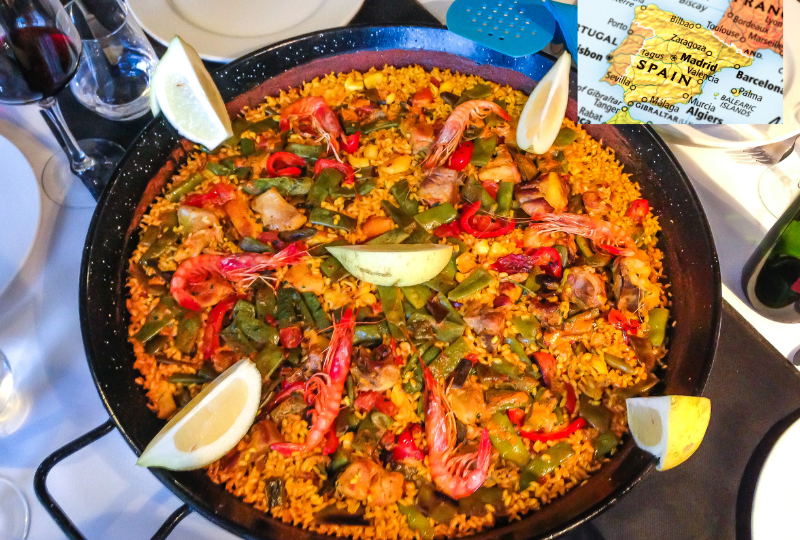Exploring the Most Popular Foods in Spain

Introduction to Spanish Cuisine
Spanish cuisine, with its rich history and cultural significance, stands as a testament to the diverse influences that have shaped it over centuries. The culinary landscape of Spain is a vibrant tapestry woven from Mediterranean, Moorish, and Roman traditions, each contributing distinct flavors and techniques that make Spanish food both unique and beloved worldwide.
One of the cornerstone elements of Spanish cuisine is its regional diversity. From the Basque Country to Andalusia, each region boasts its own culinary identity, characterized by local ingredients and traditional recipes passed down through generations. For instance, the northern regions are renowned for their pintxos and seafood dishes, while the southern areas are famous for their tapas and rich stews. This regional variety ensures that Spanish cuisine offers a wide array of tastes and textures, appealing to a broad spectrum of palates.
The Mediterranean influence is evident in the generous use of olive oil, fresh vegetables, and seafood, which form the backbone of many Spanish dishes. Moorish contributions are seen in the introduction of spices like saffron and cumin, along with the use of almonds and honey in both savory and sweet dishes. The Roman legacy is apparent in the emphasis on communal eating and the celebration of food as a social event, a tradition that continues to thrive in Spain today.
High-quality, fresh ingredients are paramount in Spanish cooking. Markets across Spain are brimming with vibrant produce, fresh seafood, and artisanal products that are integral to the preparation of traditional dishes. Whether it’s the succulent tomatoes used in gazpacho or the aromatic herbs in paella, the emphasis on freshness and quality is a defining characteristic of Spanish cuisine.
Traditional cooking methods also play a crucial role in the authenticity of Spanish food. Techniques such as slow-cooking, grilling over open flames, and curing meats are deeply rooted in Spanish culinary practices. These methods not only enhance the flavors but also preserve the cultural heritage of the cuisine.
Tapas: The Heart of Spanish Social Eating
Tapas are an integral part of Spanish dining culture, embodying the spirit of social eating that is cherished across the country. Originating in Andalusia, the concept of tapas involves serving small savory dishes that are meant to be shared among friends and family. The term “tapas” itself is derived from the Spanish verb “tapar,” meaning “to cover.” Historically, tapas were simple slices of bread or meat used to cover drinks to prevent insects from entering. Over time, they evolved into a diverse array of dishes, each with its own unique flavor and regional twist.
In Spain, tapas are typically enjoyed in a lively, social setting, such as a bustling tapas bar or a casual gathering at home. The act of sharing these small plates fosters a sense of community and conviviality, making meals a more interactive and engaging experience. Patrons often move from bar to bar, sampling different tapas and savoring the variety of flavors that each establishment offers.
Some of the most popular types of tapas include patatas bravas, croquetas, and gambas al ajillo. Patatas bravas are crispy fried potatoes served with a spicy tomato sauce, offering a delightful contrast of textures and flavors. Croquetas, on the other hand, are creamy, deep-fried breaded rolls filled with ingredients such as ham, chicken, or cheese. Gambas al ajillo features succulent shrimp cooked in a sizzling garlic and chili oil, creating an aromatic and flavorful dish that is hard to resist.
Regional variations in tapas are abundant, reflecting the diverse culinary traditions found throughout Spain. In the Basque Country, for example, pintxos are a popular form of tapas, typically served on skewers or small slices of bread. Meanwhile, in Catalonia, tapas might include dishes like pa amb tomàquet (bread with tomato) or escalivada (grilled vegetables).
The modern tapas movement has also taken the culinary world by storm, with innovative chefs reinterpreting traditional dishes and experimenting with new ingredients and techniques. This evolution has led to a renewed appreciation for tapas, both within Spain and internationally, solidifying their status as a beloved and enduring aspect of Spanish cuisine.
Spain’s culinary heritage is rich and varied, with each region offering its own unique flavors and traditional dishes. Among the most iconic Spanish dishes is paella, a renowned rice dish that originated in Valencia. Paella’s history dates back to the mid-19th century, where it was traditionally cooked by farm laborers over an open fire. The dish is known for its vibrant yellow color, imparted by saffron, a prized spice that adds a distinctive flavor. There are several varieties of paella, including the classic seafood paella featuring prawns, mussels, and clams; mixed paella, which combines seafood, chicken, and rabbit; and vegetarian paella, which highlights seasonal vegetables.
Another quintessential Spanish dish is gazpacho, a refreshing cold soup from Andalusia. Gazpacho is typically made with tomatoes, cucumbers, bell peppers, onions, garlic, olive oil, vinegar, and stale bread. This dish is especially popular during the hot summer months and is celebrated for its cooling properties and nutritional value. The preparation involves blending the ingredients until smooth, resulting in a vibrant and tangy soup that exemplifies the fresh produce of southern Spain.
In addition to paella and gazpacho, Spain boasts a variety of other notable dishes. Tortilla española, also known as Spanish omelette, is a simple yet beloved dish made from eggs, potatoes, and onions. This versatile dish can be enjoyed hot or cold and is a staple in Spanish households. Another culinary treasure is jamón ibérico, a type of cured ham produced from Iberian pigs. The ham is renowned for its rich, nutty flavor, which comes from the pigs’ diet of acorns. Chorizo, a type of pork sausage seasoned with paprika, is another essential component of Spanish cuisine. Chorizo can be eaten on its own, added to stews, or used in various recipes to impart a smoky, spicy flavor.
These dishes not only reflect the diverse regions of Spain but also demonstrate the country’s dedication to high-quality ingredients and traditional cooking methods. Whether savoring a plate of paella by the seaside or enjoying a chilled bowl of gazpacho in the Andalusian sun, one can taste the rich history and culture embedded in each bite.
Spanish Sweets and Beverages: A Culinary Delight
Spain’s gastronomic landscape is a rich tapestry of flavors, and its sweets and beverages form an essential part of this culinary delight. One cannot discuss Spanish desserts without mentioning churros con chocolate. These fried dough pastries, dusted with sugar, are traditionally dipped in a thick, rich chocolate sauce, making for a deliciously indulgent treat. Often enjoyed for breakfast or as a snack, churros are a staple in Spanish cafes and churrerías.
Another beloved dessert is flan, a creamy caramel custard that is both simple and exquisite. Originating from Roman times, this classic dessert is a fixture in Spanish households and restaurants alike. Similarly, turrón is a festive favourite, especially around Christmas. This nougat confection, made from almonds, honey, sugar, and egg whites, comes in various textures, from the crunchy turrón de Alicante to the soft turrón de Jijona.
When it comes to beverages, Spain offers a diverse array of traditional drinks. Sangria, a refreshing punch made from red wine, chopped fruit, and a splash of brandy, is synonymous with Spanish summer gatherings. Cava, Spain’s sparkling wine, hails from Catalonia and is often enjoyed during celebrations. Another unique beverage is horchata, a sweet, milky drink made from tiger nuts, water, and sugar, originating from Valencia.
Spain’s coffee culture is also noteworthy. The Spanish take their coffee seriously, with popular choices like café solo (a strong espresso) and café con leche (coffee with milk). Coffee breaks are integral to the daily routine, often extending into a practice known as sobremesa. This tradition of lingering over a meal, engaging in conversation, and enjoying a relaxed atmosphere is a cornerstone of Spanish dining etiquette, emphasizing the importance of social connection and leisure.
In summation, Spanish sweets and beverages are a testament to the country’s rich culinary heritage. From the sugary delights of churros and flan to the refreshing notes of sangria and cava, these treats offer a taste of Spain’s vibrant culture and traditions.
RELATED POSTS
View all


